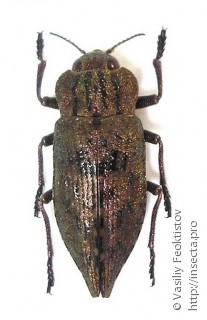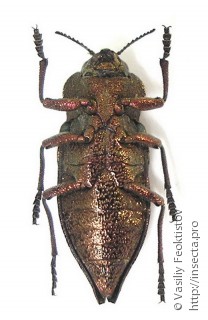Dicerca moesta (Fabricius, 1793)

Taxonomy
class Insecta → subclass Pterygota → infraclass Neoptera → superorder Holometabola → order Coleoptera → suborder Polyphaga → infraorder Elateriformia → superfamily Buprestoidea → family Buprestidae → subfamily Chrysochroinae → tribe Dicercini → subtribe Dicercina → genus Dicerca → subgenus Argante → species Dicerca moesta
Species name(s)
Dicerca (Argante) moesta (Fabricius, 1793) = Dicerca divaricata Sahlberg 1913 = Buprestis quadrilineata Herbst 1801. [10]
urn:lsid:insecta.pro:taxonomy:991763
Expansion
This species marks on the maps: 1.
Zoogeographical regions
Palaearctic.

Detailed information with references
Distribution
- Albania, Austria, Belarus, Bosnia and Herzegovina, Bulgaria, Croatia, Czech Republic, Estonia, Finland, French mainland, Germany, Greek mainland, Hungary, Italian mainland, Latvia, Lithuania, Macedonia, Moldova, Norwegian mainland, Poland, Russia (Central, Northwest, Kaliningrad region), Slovakia, Spanish mainland, Sweden, Ukraine, Serbia, Kosovo, Voivodina, Montenegro, East Palaearctic [10].
- In Russia, it inhabits taiga forests from Finland to the Urals. [260].
Imago Habitus and Differences from alike species
- Body length is 12-17 mm. Medium-sized stocky and angular beetle with a slightly flattened and elongated body. Body surface with distinct bumps and pits. Pronotum with two longitudinal, almost parallel, keels in the middle and two on the sides. The color of the upper side of the body is black with a bronze sheen, the bottom is shiny with a reddish tint. The tops of the elytra are slightly elongated and obliquely cut off at the end. It differs from similar species in the rough structure of the integument, well-developed pronotum keels, as well as the absence of edging and the roughly dotted surface of the prothorax process between the second pair of legs. [260].
General info about Imago
- Adult beetles are thermophilic and fly well. [260].
General info about Larva
- The body of the larva is flattened, on the broad prothorax there are motor calluses, with the help of which it moves in the wood. First, the larva penetrates the winding passages under the bark, then goes into the wood. The course in cross-section is oval, as in other types of goldsmiths. [260].
Larva food plants / other food objects
- The larva feeds on the drying and dead wood of firs and pines. [260].
Authors
Initial species uploading to the site: Peter Khramov.
Photos:
Vasiliy Feoktistov. Text data: Vasiliy Feoktistov.
The species characteristics formalization: Peter Khramov, Vasiliy Feoktistov.
References
- [10] de Jong, Y.S.D.M. (ed.) (2011) Fauna Europaea version 2.4 (faunaeur.org)
- [260] ИАС «ООПТ РФ» ООПТ России ФГБУ "ААНИИ", Лаборатория геоинформационных технологий http://oopt.aari.ru/
Comments
Note: you should have a Insecta.pro account to upload new topics and comments. Please, create an account or log in to add comments
Dicerca moesta photos
Other species Dicerca









